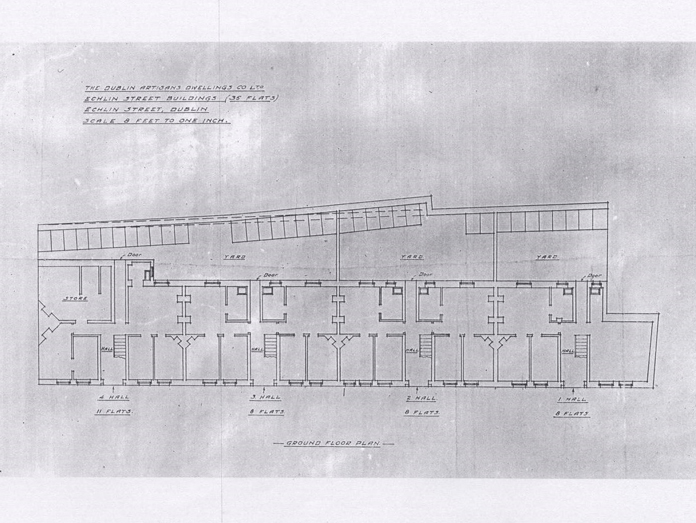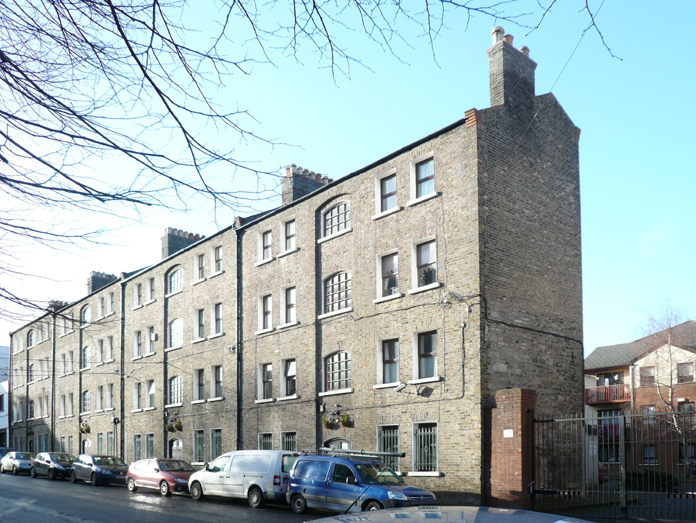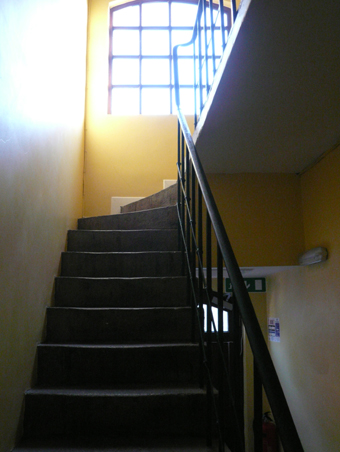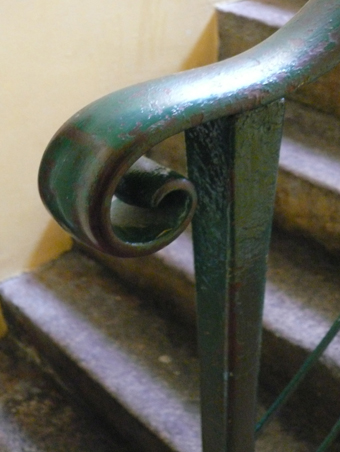Building of the Month - August 2016


The Echlin Buildings, off James’ Street, is Dublin’s first purpose-built block of flats and opened in March 1878. The location of these homes for workers reflected the industrial character of a district which included breweries, distilleries and a major wharf on the Grand Canal. Although the street appears on maps dating from the 1860s, Echlin Street was first listed in Thom‘s Irish Almanac and Official Directory only in 1879, just after the Echlin Buildings were occupied, presumably because of the arrival of a significant number of new ratepayers.
The Echlin Buildings were commissioned by the Dublin Artisan Dwelling Company (DADC), a company founded in 1876 with the aim of tackling the city’s chronic housing problems, albeit for a profit. Under its chairman, Sir Arthur Guinness (1840-1915), the DADC engaged two prominent architects on its initial projects, Thomas Newenham Deane (1827-99) and Thomas Drew (1838-1910). However, the company proved to be a difficult client and neither architect remained in their employ for long. Deane left after completing the first two housing projects in Echlin Street and Dominick Street Upper.
 Adj Sepia.jpg)
An extract from the Ordnance Survey published in 1864 showing the site leased by the Dublin Artisan Dwelling Company from the Grand Canal Company at a rate of £15 per annum and its proximity to such industrial sites as the Grand Canal Harbour and the Guinness Brewery
In 1876 the DADC leased a site measuring 143 feet by 50 feet from the Grand Canal Company at a rate of £15 per annum. Deane’s initial plan, to erect twelve cottages at a cost of £1,000, was scrapped in favour of a proposal to construct a block of thirty flats for £2,820. This would substantially increase the rental income. Work began after some wrangling over some additional items that the builder, John Cunningham, felt were needed:
| 1 | Slating to be usual instead of open | £30 |
| 2 | Doors 1½” 4 panelled instead of ledged | £43 |
| 3 | 14 dill close to 17 supply cisterns with Vartry [mains water] supply and 9″ sewer from same | £43 |
| 4 | 32 scullery troughs with Vartry supply and cocks and soil pipe to 9″ drain | £64 |
| 5 | Painting 4 coats £16 per block | £66 |
| 6 | One sash hang to each window | £27 |
| 7 | Additional 2 feet breadth to building | £115 |
| 8 | Asphalting yards | £45 |
| 9 | 3 division walls 7 feet high and 9″ thick | £12 |
The DADC agreed to all of Cunningham’s list with the exception of the sash windows, and reduced the additional breadth of the building to one foot, bringing the total cost to £3,092, or £103 per unit.

The architect engaged by the DADC, Thomas Newenham Deane (1827-99), originally proposed a scheme of twelve cottages for the Echlin Street site. However, in order to boost revenue the initial scheme was scrapped in favour of a block of thirty flats arranged over four floors. An unsigned and undated drawing shows the ground floor plan of the Echlin Buildings with eleven flats housed in the block on the far left and eight flats housed in the remaining three blocks. Each flat included a kitchen, sitting room and two bedrooms, accommodations that far exceeded the standard endured by so many in Dublin’s notorious squalid tenements. Courtesy of the Irish Architectural Archive (9/82 R1)
On Christmas Eve 1877, as work was nearing completion, the DADC ‘resolved that the name of the houses in Echlin St. be The Echlin Buildings‘ and the first tenants took up residence in March 1878. The DADC’s Dominick Street Upper site, also known as Buckingham Street or Temple Buildings, was not completed until the following May, conferring on the Echlin Buildings the status as Dublin’s first purpose-built block of flats.

The Echlin Buildings present the appearance of four adjoining, symmetrically-fronted blocks faced with yellow brick. The internal arrangement of each block is reasonably clear from the street with a central stairwell, expressed by a full-height recess with camber-headed window openings, giving access to flats on each side. Keen to keep costs down, and boost the DADC’s profits, the Echlin Buildings show a minimum of superfluous ornamentation and might well be regarded as functional, if not severe in appearance. Copyright Norman Mongan (2016)
Rents on the new flats ranged from two shillings-and-sixpence to five shillings-and-sixpence per week. At first not all of the flats were occupied and some tenants moved out after only a few months. Consequently, the rental income from the Echlin Buildings fluctuated in the early years. It appears that even in a city of overcrowded tenements, clean and modern housing did not automatically attract new tenants. Price was an important consideration and the typical casual labourer could not afford the four shillings average weekly rent, payable in advance, on a DADC flat. Fear of being laid off, coupled with the company’s reputation as an efficient, and often ruthless, rent-collector, meant that the traditional shared tenement room was considered a safer prospect for many families. The DADC was concerned about these vacancies, and the impact on their profits, and placed posters around Dublin promoting the flats.
But for those who could afford them, the Echlin Buildings were a marked improvement in living conditions. In the 1871 Census just under 26,000 Dublin families – 44% of the population – were listed as living in fourth class single-room accommodations. Typically these were rooms in decaying Georgian houses, occasionally shared with other families, with a single outdoor communal privy serving all occupants of the house. Unsurprisingly, disease and infant mortality were commonplace. In contrast, six months after the first tenants moved into the Echlin Buildings, the DADC was pleased to announce that there had not been a single death in any of the company’s flats.
Little survives of the DADC’s records relating to the construction or initial occupation of the Echlin Buildings. However, using Dublin Corporation’s ratepayer records, some information on the first residents and their conditions can be gleaned. Eight of the thirty-six units were vacant in 1882. Only one householder was female. The average rent varied according to location with tenants occupying street level flats paying five shillings-and-sixpence per week and tenants occupying the fourth floor paying three shillings-and-fourpence. Curiously, the city council took a different approach when calculating the rateable valuations and placed the first floor flats in a higher tax band than the ground floor or upper floor flats.


Copyright Norman Mongan (2016)
The folk history of Dublin’s slums presents all tenement dwellers as equally poor. The Echlin Buildings prove that this was not the case. Some had the money and secure employment to improve their living conditions as evidenced by the uptake when the DADC launched its first scheme. What might appear to the modern observer as basic housing for humble labourers were in fact well-built and properly maintained homes for the artisan elite. The flats became a symbol of comparative prosperity and social status amongst the city’s working classes. As its directors were at pains to make clear, the DADC was not a charity. The company would only succeed if investors got a return on their investments, and this could only be achieved by attracting reliable tenants with suitable homes at an appropriate rent.
Twenty-five years later the Iveagh Trust, a philanthropic trust established by Arthur Guinness’ brother Edward Cecil Guinness (1847-1927), would develop a better model for residential blocks with larger units, improved facilities at more affordable rents. Bettered, certainly, but the Echlin Buildings could still claim the status as the first example of this new style of accommodation in Dublin.
Ultimately, Dubliners who could afford to move out of tall, overcrowded slums did not want to relocate to another tall, multi-tenanted building with shared hallways and yards, no matter how architecturally designed, newly built and centrally located. Consequently, the DADC phased out its plans for tenement blocks in the 1880s and instead began to focus on terraces of single-storey cottages and two-storey houses in The Coombe, Rialto and Stoneybatter. Dublin Corporation, having begun to address social housing needs with blocks of flats in Benburb Street and Foley Street, also realised that tenants wanted their own front door and back yards.
The Echlin Buildings therefore survive as a monument to the mid Victorian concept of philanthropy as a commercial concern. A social experiment, one that addressed tenants’ needs but not necessarily their wants, the Echlin Buildings can be seen as a step towards the low-level terraces that came to shape artisan housing in Dublin.
Ciarán Wallace completed his doctorate in 2010 on Local Politics and Government in Dublin City & Suburbs: 1899 – 1914. He currently lectures in Irish history and Irish studies at DCU, Mater Dei Campus. His co-edited collection, Grave Matters:
Back to Building of the Month Archive